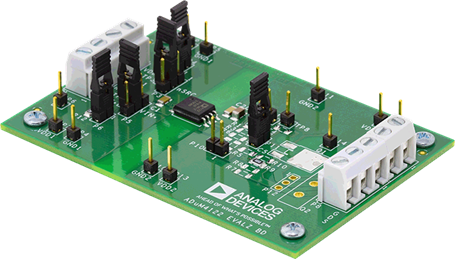Supplier sections
Rate this page
Analog Devices Launches Isolation Technology Maximizing Power Efficiency & Minimizing Emissions to Support Industry 4.0, Eval board and Samples available from Anglia.

Analog Devices has released a simple power solution that maximizes efficiency and minimizes electromagnetic (EM) emissions of motion systems as equipment manufacturers migrate to higher density automation. The ADuM4122, an isolated, dual-drive strength output driver that uses Analog Devices iCoupler® technology, empowers designers to harness the benefits of higher efficiency power switch technologies.
Electric motor-driven systems account for 40% of global electricity consumption, according to the International Energy Agency, improvements in motor efficiency can have wide-reaching economic and environmental benefits. With the increased adoption of industrial automation and IoT within smart factories, Analog Devices have recognised the growing demand for intelligent technology and features within systems to ensure maximum efficiency. The ADuM4122 is the first simple solution that accomplishes this by controlling how fast or slow a MOSFET or IGBT turns on or off by user command, on the fly, thereby controlling motor currents.
The ADuM4122 is an isolated, single device, dual output driver that uses iCoupler® technology to provide precision isolation, providing 5 kV rms isolation in a standard wide-body, 8-lead SOIC package. These isolation components combine high speed complementary metal-oxide semiconductor (CMOS) and monolithic transformer technology to provide performance characteristics superior to alternatives (such as a combination of pulse transformers and gate drivers).
The ADuM4122 operates with an input supply voltage range from 3.3 V to 6.5 V, providing compatibility with lower voltage systems. Unlike gate drivers that employ high voltage level translation methodologies, the ADuM4122 offers true galvanic isolation between the input and the output regions.
The ADuM4122 includes two output pins that facilitate slew rate control of two output drive strengths. The VOUT pin follows the logic of the VIN+ pin, while the boosting output, VOUT_SRC, can be toggled to follow the VIN+ pin or to go high-Z. The toggling of the slew rate is controlled by the primary side. Slew rate control can allow for electromagnetic interference (EMI) mitigation and voltage overshoot control.
An internal thermal shutdown sets outputs low if internal temperatures on the ADuM4122 exceed the thermal shutdown temperature. As a result, the ADuM4122 provides reliable control over the switching characteristics of insulated gate bipolar transistor (IGBT) and metal-oxide semiconductor field effect transistor (MOSFET) configurations over a wide range of switching voltages, allowing for simple slew rate control.
The new ADuM4122 is a simple dual-drive strength output driver that efficiently toggles between two slew rates controlled by a digital signal. Smaller than existing discrete or complex integrated solutions that have 20 or more pins, the ADuM4122 features only eight pins and works in a variety of operating conditions. The ADuM4122 further improves system capabilities with high common-mode transient immunity and low propagation delay for high performance applications.
The ADuM4122 is suitable for industrial applications including Switching power supplies, Isolated IGBT and MOSFET gate drivers, Energy systems, Robotics, Industrial inverters and Motor control systems.
Evaluation Board

The EVAL-ADuM4122EBZ evaluation board supports the ADuM4122 isolated gate driver with slew rate control. iCoupler® technology provides isolation between the ADuM4122 input signal and the output gate driver. The evaluation board supplies jumpers and screw terminals to configure different drive conditions. The EVAL-ADuM4122EBZ board operates with square waves and dc values on the VIN+ and SRC pins.
The EVAL-ADuM4122EBZ board tests the propagation delay, drive strength, slew rate selection, and input logic of the device.
Key features
- 2 A output current per output pin (<3 Ω RDSON_X)
- 3 A peak short-circuit current
- 3.3 V to 6.5 V, VDD1
- 4.5 V to 35 V, VDD2
- Positive going threshold, UVLO at 3.3 V VDD1
- Multiple positive going thresholds, UVLO options on VDD2
- Grade A: 4.4 V (typical) positive going threshold, UVLO
- Grade B: 7.3 V (typical) positive going threshold, UVLO
- Grade C: 11.3 V (typical) positive going threshold, UVLO
- Precise timing characteristics
- 48 ns maximum propagation delay for falling edge
- CMOS input logic levels
- High common-mode transient immunity: >150 kV/µs
- High junction temperature operation: 125°C
- Default low output
- Selectable slew rate control
- Safety and regulatory approvals (pending)
- UL recognition per UL 1577
- 5 kV rms for 1 minute
- CSA Component Acceptance Notice 5A
- VDE certificate of conformity (pending)
- DIN V VDE V 0884-10
- VIORM = 849 V peak
- Wide-body, 8-lead SOIC Package
- UL recognition per UL 1577
Click here for more information or to buy from Anglia Live.
Click here to download the ADuM4122 Datasheet.
Click here to download the EVAL-ADuM4122 Eval Board User Guide.
Anglia are offering customers a FREE evaluation board and samples of the ADuM4122 isolated, dual-drive strength output driver from Analog Devices, please fill in the form below to register for your FREE samples now.
Requesting....
To register for a FREE evaluation board and samples of the ADuM4122 isolated dual-drive output driver from Analog Devices, please fill in the form below.
| First name | * |
| Last name | * |
| Company | * |
| Telephone | * |
| Email Address | * |
| Project Name | |
| Project Volume | * |
Free samples are subject to availability.
For more information, or details on the full range of Analog Devices products available from Anglia, please email info@anglia.com
This news article was originally published in November 2019.








































































































































